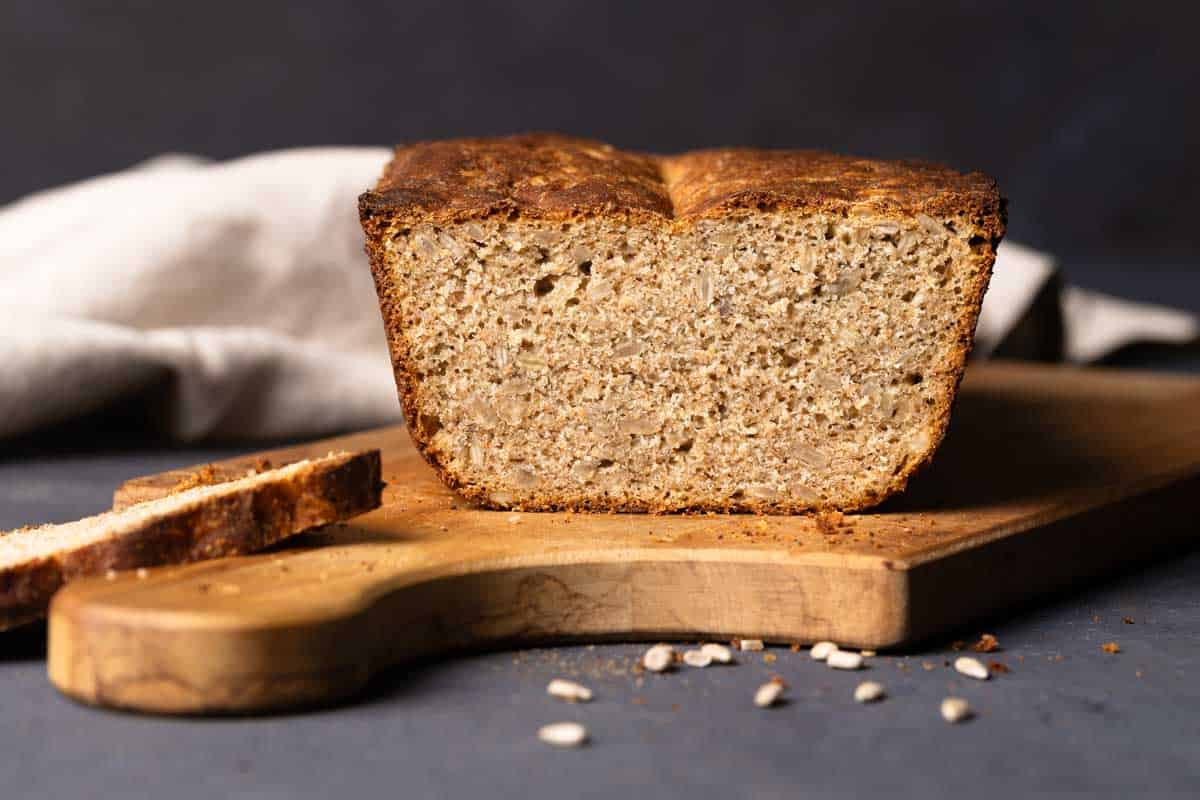Rye Sandwich Bread
This wholesome rye sandwich bread is made with whole grain rye flour and packed with sunflower seeds. It’s a rich and earthy sandwich loaf that’s easy to make, even for beginner bread makers.

Growing up in Westphalia in Germany, rich rye bread has been a staple in my diet from a very young age. Although this whole grain rye bread isn’t as moist and hearty as the classic Pumpernickel, it’s incredibly quick and easy to make and offers the classic taste and texture of rye bread found in traditional German bakeries.
With only 8 ingredients and 20 minutes of hands-on prep time, even beginner bakers can make this yeasted rye sandwich loaf. For more easy bread recipes check out my no-knead spelt bread and leftover whey bread as well.
If you loved this Rye Sandwich Bread Recipe or any other recipe on my website, please leave a 🌟 star rating below. Thank you!
Rye Sandwich Bread
Ingredients
- 1 1/2 cups lukewarm filtered water
- 7 g instant yeast 1 packet
- 2 tbsp maple syrup or molasses
- 350 g whole grain rye flour
- 150 g all-purpose flour or bread flour
- 1 1/2 tsp salt
- 2 tbsp olive oil
- 1 cup sunflower seeds
Instructions
- In a bowl, combine warm water, maple syrup, and the instant yeast. Let it sit for 2-3 minutes until it's starting to froth up.1 1/2 cups lukewarm filtered water, 7 g instant yeast, 2 tbsp maple syrup
- In a large mixing bowl, combine rye flour, all-purpose flour, sunflower seeds, and salt.350 g whole grain rye flour, 150 g all-purpose flour, 1 1/2 tsp salt, 1 cup sunflower seeds
- Pour the yeast mixture into the flour mixture. Add olive oil and mix until combined. Knead for 10 minutes. The dough will be clay-like and extremely sticky. Wet your hand lightly to knead the dough or use the dough hook on your stand mixer.2 tbsp olive oil
- The the dough into a ball and place it into a clean bowl. Cover it with a damp cloth and let the dough rise in a warm place for 2 hours, or until doubled in size.
- Preheat your oven to 400°F (200°C). Transfer the dough to a greased loaf pan.
- Let the shaped dough rise for another 30 minutes in the pan, or until it reaches just above the rim of the pan.
- Bake the loaf in the preheated oven for 40 minutes until dark brown. Check its crust after 30 minutes and cover it with baking paper if needed.
- Remove the rye bread from the pan and cool it completely on a wire rack before slicing. Enjoy!
Notes
Nutrition
Ingredients and substitutions
- Rye flour – I mill my own flour from rye berries but you can buy dark or whole rye flour from specialist or wholefood stores. While it’s possible to use 100% rye flour, be aware that rye flour doesn’t have the same gluten content as wheat and the texture will be different. I recommended mixing it with a portion of all-purpose flour or bread flour as per the recipe below for better results.
- Water – Use lukewarm filtered water at approximately 100°F (37°C).
- Instant yeast – I use instant yeast for convenience but you can also opt for active dry yeast or 1 tbsp of fresh yeast. Both will need activating before using it.
- Seeds – I use sunflower seeds but any seeds can be added to the sandwich loaf including pumpkin seeds, sesame seeds, or flaxseeds. Incorporate 1/2 tsp if caraway seeds for a more traditional rye flavor. Or you can go nuts and substitute 1/2 cup of seeds with chopped nuts, like walnuts or hazelnuts, for an extra crunch.
My top 3 rye bread tips
Achieving an ideal rise is crucial for the texture and flavor of your rye bread as the rye flour like many other ancient grains is low in gluten. The key is to maintain the right environment for the dough to expand. Here are some tips:
- Warmth: Ensure that the place where you let the dough rise is comfortably warm but not too hot. A temperature of around 75-80°F (24-27°C) is generally suitable. If your kitchen is cold, you can create a warm environment by turning on your oven at a low temperature for a few minutes and then turning it off before placing the dough inside.
- Covering: Use a damp cloth to cover the dough during its rising period. This helps prevent the surface from drying out and forming a crust, allowing the dough to expand freely.
- Patience: Don’t rush the rising process. Give the dough ample time to double in size, which typically takes about 1.5-2 hours. Rushing it may result in a denser loaf.


